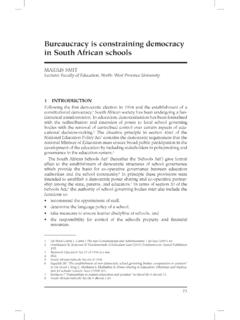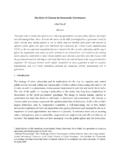Transcription of a practical guide on how to prepare and write a ...
1 A practical guide on how to prepare and write a feasibility study for setting up a social enterprise social enterprise Planning Toolkit By Freer Spreckley Local Livelihoods Supported by the British Council Connecting the UK to the world and the world to the UK, the British Council is the UK's international cultural relations body. The British Council offers international opportunities to the people of the UK and other countries and builds trust between them worldwide. First Edition June 2011. Published by: The British Council Content Section One 1 How to use the social enterprise Planning Toolkit 2 A History of social enterprise 3 A Definition of social enterprise Section Two 4 Planning for social enterprise 5.
2 Identify your Stakeholders and Customers 6. Develop the social enterprise Idea 7. Marketing 8. Finance 9. social enterprise Organisation 10. social Accounting and Audit 11. Legal Issues Section Three 12 The social enterprise Plan Headings 13 social enterprise Plan Self-Assessment Section One In this section we present a guide to how to use this toolkit and an overview of social enterprise and its history and background. This social enterprise Planning Toolkit is a practical how to' manual for those wishing to form a new social enterprise or expand an existing social enterprise . The Toolkit has developed from a series of practical training courses in social enterprise planning designed and delivered by the author on behalf of the British Council in five countries in the Balkans and Caucuses during 2010/11.
3 During the course of the training programme it was decided to consolidate the training material into the basis of a supporting Toolkit. This Toolkit is also based on the author's extensive knowledge and experience of supporting individuals and groups to plan and establish social enterprises. The Toolkit has been designed to be used as supporting material for training in social enterprise planning; as a self-help guide to individuals and groups establishing their own social enterprise ; or for those wishing to plan for expansion of their social enterprise . 1. How to use the social enterprise Planning Toolkit The social enterprise Planning Toolkit is designed to be a basic process guide to carrying out a feasibility study of an enterprise idea, and then writing the enterprise plan in order to be able to present it to potential supporters.
4 It can also be used as a guide to the basic systems for managing social enterprises. The toolkit is divided into three sections: Section One is an overview of social enterprise and the history and background. Section Two is the main part of the Toolkit and provides the information and exercises for developing the social enterprise idea and testing its viability. Section Three is the outline of the content required in a social enterprise Plan, to guide groups and individuals, as they bring the information gathered during the Section 2. processes together, in preparing and writing a plan. 1. 2. A History of social enterprise social disquiet is driven by perceptions of unfairness, a lack of democracy , ownership and power in too few hands, and for many peoples few opportunities to acquire the resources needed to develop their own ideas.
5 Consequently civil society worldwide is adopting the values of fairness, equality and inclusiveness, not only in parliaments but also in workplaces, where viability is now being broadened to include not only commercial independence, but also social wealth creation and environmental responsibility; a more generous approach. To facilitate this a new business model is being used. social enterprise was created to provide an alternative approach to the private sectors'. narrow value of profit maximisation. social enterprise provides fairness, democracy and social and environmental responsibility all in one method; it is the modern enterprise method for the 21st century, but one which basically maintains the good parts of market economics where anyone can freely trade based on supply and demand and open competition.
6 However, the origins of social enterprises and co-operative forms of activity are founded in the early social struggles of the 17th century. In the UK groups styled the Diggers took over land and cultivated it in common, organised themselves around the idea of one person one vote and equal distribution of wealth. This first experiment in co-operative forms of organisation established the idea of integrating social and commercial activities. What the Diggers lacked was ownership of the land they had taken over and thus they were eventually driven off. In 1659 a Dutchman, Peter Cornelius produced a clear vision of how production could be organised in a way which was democratic and socially orientated; in his booklet A Way Propounded' he firmly stated the need for new forms of ownership if anything was to come of the then new ideas' of democracy .
7 He proposed that there should be common ownership over land and certain commercial activities. Much later on Co-operative forms of organisation began to appear; in 1830 a number of unemployed millers took over the operation of an old mill in Hull to provide flour for their families and other members of the community who were in need. As with the Diggers two centuries earlier their aims were more social than profit orientated, and like the diggers they did not own the mill and were finally moved out. As capitalism gained ascendancy pioneers such as Robert Owen (1771-1858) influenced the newly formed trade unions to favour the establishment of an alternative means of organising society.
8 Owen urged the working classes to set up groups of producers with common ownership of the means of production. He advocated the idea of co-operatives not solely for commercial purposes but as social enterprises reaching out to the community and integrating community and commercial values. Owen's ideas were extremely popular. As a 2. result many co-operative societies and shops were founded, Labour exchanges were set up, and the concept of socialism was developed. Marx and Engels, throughout their writings, defined their idea of a socialist system as a society composed of association of free and equal producers a definition which in principle would apply without any difficulty to collectively-owned enterprises.
9 The Rochdale Society of Equitable Pioneers (1844) extended their influence beyond the immediate consumer to the wider interests of the community, the ideas on democratic management and voting rights were part of their doctrine; and many of the areas of the welfare state in the UK today were originally inspired from the co-operative societies and promoted through their free meeting halls. The first major principle of the traditional co-operative movement was open membership to all on a voluntary basis. Over time, however, this created a large unwieldy consumer membership which overtime lost sight of its principles. In many countries co-operatives became uncompetitive and ceased trading or annexed as part of the state's instrument for organising small producers and exporting commodities such as coffee and cocoa.
10 In the co-operative enterprises based on collective forms of ownership by the workforces, a participatory principle was adopted which restricted membership to workers only. In 1978 at Beechwood College in Yorkshire, UK, the Industrial Common Ownership Movement's (ICOM) training college the concept and structure of social enterprise was firmly established and defined. The then new social enterprise had the basic rules of co- operative and common ownership businesses, each member owning one share and each share giving each member one vote in the general governance of the enterprise , but the Triple Bottom Line was added whereby the enterprise took on responsibility for not only being financially viable but for creating social wealth and being environmentally responsible in the way it operated and from where it sourced its supplies.






